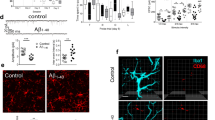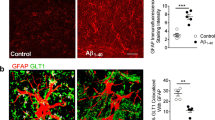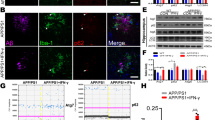Abstract
We previously reported the critical involvement of metabotropic GluR1 (mGluR1) signaling in complement C1q-dependent microglial phagocytosis of glutamatergic synapses in a rat model of Alzheimer’s disease (AD) injected with amyloid fibrils. Here, we explored the role of type 2A protein phosphatase (type 2A PPase), a key enzyme downstream of mGluR1 signaling, in the pathogenesis of AD in rats. Significant local upregulation of PP2A expression was observed in the hippocampal CA1 after bilateral microinjection of amyloid-beta (Aβ1-40) fibrils. Amyloid fibrils induced remarkable dephosphorylation of pFMRP (fragile X mental retardation protein) and C1q upregulation in hippocampal glutamatergic synapses, which was ameliorated by microinjection of type 2A PPase inhibitor okadaic acid (OA). Microinjection of OA further attenuated the microglial phagocytosis of glutamatergic synapses, recovered the hippocampal glutamatergic transmission, and improved the performance in Morris water maze test. These findings demonstrated that dysfunction of type 2A PPase signaling contributed to complement C1q-dependent microglial phagocytosis of glutamatergic synapses and the cognitive impairments in the rat model of AD.





Similar content being viewed by others
Data Availability
The original dataset for analysis in the present study is available upon reasonable request from the corresponding author.
References
Hong S, Beja-Glasser VF, Nfonoyim BM, Frouin A, Li S, Ramakrishnan S, Merry KM, Shi Q, Rosenthal A, Barres BA, Lemere CA, Selkoe DJ, Stevens B (2016) Complement and microglia mediate early synapse loss in Alzheimer mouse models. Science 352(6286):712–716. https://doi.org/10.1126/science.aad8373
Lui H, Zhang J, Makinson SR, Cahill MK, Kelley KW, Huang HY, Shang Y, Oldham MC, Martens LH, Gao F, Coppola G, Sloan SA, Hsieh CL, Kim CC, Bigio EH, Weintraub S, Mesulam MM, Rademakers R, Mackenzie IR, Seeley WW, Karydas A, Miller BL, Borroni B, Ghidoni R, Farese RV Jr, Paz JT, Barres BA, Huang EJ (2016) Progranulin deficiency promotes circuit-specific synaptic pruning by microglia via complement activation. Cell 165(4):921–935. https://doi.org/10.1016/j.cell.2016.04.001
Thion MS, Garel S (2018) Microglia under the spotlight: activity and complement-dependent engulfment of synapses. Trends Neurosci 41(6):332–334. https://doi.org/10.1016/j.tins.2018.03.017
Bie B, Wu J, Foss JF, Naguib M (2019) Activation of mGluR1 mediates C1q-dependent microglial phagocytosis of glutamatergic synapses in Alzheimer’s rodent models. Mol Neurobiol 56(8):5568–5585. https://doi.org/10.1007/s12035-019-1467-8
Prickett TD, Brautigan DL (2006) The alpha4 regulatory subunit exerts opposing allosteric effects on protein phosphatases PP6 and PP2A. J Biol Chem 281(41):30503–30511. https://doi.org/10.1074/jbc.M601054200
Narayanan U, Nalavadi V, Nakamoto M, Pallas DC, Ceman S, Bassell GJ, Warren ST (2007) FMRP phosphorylation reveals an immediate-early signaling pathway triggered by group I mGluR and mediated by PP2A. J Neurosci 27(52):14349–14357. https://doi.org/10.1523/JNEUROSCI.2969-07.2007
Kim SH, Markham JA, Weiler IJ, Greenough WT (2008) Aberrant early-phase ERK inactivation impedes neuronal function in fragile X syndrome. Proc Natl Acad Sci U S A 105(11):4429–4434. https://doi.org/10.1073/pnas.0800257105
Zimmer ER, Leuzy A, Souza DO, Portela LV (2016) Inhibition of protein phosphatase 2A: focus on the glutamatergic system. Mol Neurobiol 53(6):3753–3755. https://doi.org/10.1007/s12035-015-9321-0
Niere F, Wilkerson JR, Huber KM (2012) Evidence for a fragile X mental retardation protein-mediated translational switch in metabotropic glutamate receptor-triggered Arc translation and long-term depression. J Neurosci 32(17):5924–5936. https://doi.org/10.1523/JNEUROSCI.4650-11.2012
Javadpour P, Dargahi L, Ahmadiani A, Ghasemi R (2019) To be or not to be: PP2A as a dual player in CNS functions, its role in neurodegeneration, and its interaction with brain insulin signaling. Cell Mol Life Sci 76(12):2277–2297. https://doi.org/10.1007/s00018-019-03063-y
Pei JJ, Gong CX, Iqbal K, Grundke-Iqbal I, Wu QL, Winblad B, Cowburn RF (1998) Subcellular distribution of protein phosphatases and abnormally phosphorylated tau in the temporal cortex from Alzheimer’s disease and control brains. J Neural Transm (Vienna) 105(1):69–83. https://doi.org/10.1007/s007020050039
Wei H, Zhang HL, Wang XC, Xie JZ, An DD, Wan L, Wang JZ, Zeng Y, Shu XJ, Westermarck J, Lu YM, Ohlmeyer M, Liu R (2020) Direct activation of protein phosphatase 2A (PP2A) by tricyclic sulfonamides ameliorates Alzheimer’s disease pathogenesis in cell and animal models. Neurotherapeutics 17(3):1087–1103. https://doi.org/10.1007/s13311-020-00841-6
Gong CX, Singh TJ, Grundke-Iqbal I, Iqbal K (1993) Phosphoprotein phosphatase activities in Alzheimer disease brain. J Neurochem 61(3):921–927. https://doi.org/10.1111/j.1471-4159.1993.tb03603.x
Wu J, Bie B, Foss JF, Naguib M (2020) Amyloid fibril-induced astrocytic glutamate transporter disruption contributes to complement C1q-mediated microglial pruning of glutamatergic synapses. Mol Neurobiol 57(5):2290–2300. https://doi.org/10.1007/s12035-020-01885-7
Bie B, Wu J, Yang H, Xu JJ, Brown DL, Naguib M (2014) Epigenetic suppression of neuroligin 1 underlies amyloid-induced memory deficiency. Nat Neurosci 17 (2):223–231. https://doi.org/10.1038/nn.3618http://www.nature.com/neuro/journal/vaop/ncurrent/abs/nn.3618.html#supplementary-information
Shin RW, Ogino K, Kondo A, Saido TC, Trojanowski JQ, Kitamoto T, Tateishi J (1997) Amyloid beta-protein (Abeta) 1–40 but not Abeta1-42 contributes to the experimental formation of Alzheimer disease amyloid fibrils in rat brain. J Neurosci: Off J Soc Neurosci 17(21):8187–8193
Ahmed T, Enam SA, Gilani AH (2010) Curcuminoids enhance memory in an amyloid-infused rat model of Alzheimer's disease. Neuroscience 169 (3):1296–1306. S0306–4522(10)00818–3 https://doi.org/10.1016/j.neuroscience.2010.05.078
Chacon MA, Barria MI, Soto C, Inestrosa NC (2004) Beta-sheet breaker peptide prevents Abeta-induced spatial memory impairments with partial reduction of amyloid deposits. Mol Psychiatry 9(10):953–961. https://doi.org/10.1038/sj.mp.4001516
Bie B, Zhang Z, Cai YQ, Zhu W, Zhang Y, Dai J, Lowenstein CJ, Weinman EJ, Pan ZZ (2010) Nerve growth factor-regulated emergence of functional delta-opioid receptors. J Neurosci 30(16):5617–5628. https://doi.org/10.1523/JNEUROSCI.5296-09.2010
Paxinos G, Watson C (1998) The rat brain in stereotaxic coordinates. vol 1, 4th edition edn. Academic Press, New York
Wu J, Bie B, Yang H, Xu JJ, Brown DL, Naguib M (2013) Activation of the CB(2) receptor system reverses amyloid-induced memory deficiency. Neurobiol Aging 34:791–804. https://doi.org/10.1016/j.neurobiolaging.2012.06.011
Bie B, Brown DL, Naguib M (2011) Increased synaptic GluR1 subunits in the anterior cingulate cortex of rats with peripheral inflammation. Eur J Pharmacol 653(1–3):26–31. https://doi.org/10.1016/j.ejphar.2010.11.027
Peritz T, Zeng F, Kannanayakal TJ, Kilk K, Eiriksdottir E, Langel U, Eberwine J (2006) Immunoprecipitation of mRNA-protein complexes. Nat Protoc 1(2):577–580. https://doi.org/10.1038/nprot.2006.82
Zhang M, Wang Q, Huang Y (2007) Fragile X mental retardation protein FMRP and the RNA export factor NXF2 associate with and destabilize Nxf1 mRNA in neuronal cells. Proc Natl Acad Sci U S A 104(24):10057–10062. https://doi.org/10.1073/pnas.0700169104
Li Y, Stockton ME, Bhuiyan I, Eisinger BE, Gao Y, Miller JL, Bhattacharyya A, Zhao X (2016) MDM2 inhibition rescues neurogenic and cognitive deficits in a mouse model of fragile X syndrome. Sci Transl Med 8(336):336ra361. https://doi.org/10.1126/scitranslmed.aad9370
Schafer DP, Lehrman EK, Kautzman AG, Koyama R, Mardinly AR, Yamasaki R, Ransohoff RM, Greenberg ME, Barres BA, Stevens B (2012) Microglia sculpt postnatal neural circuits in an activity and complement-dependent manner. Neuron 74(4):691–705. https://doi.org/10.1016/j.neuron.2012.03.026
Winder DG, Sweatt JD (2001) Roles of serine/threonine phosphatases in hippocampal synaptic plasticity. Nat Rev Neurosci 2(7):461–474. https://doi.org/10.1038/35081514
Wu J, Bie B, Yang H, Xu JJ, Brown DL, Naguib M (2013) Suppression of central chemokine fractalkine receptor signaling alleviates amyloid-induced memory deficiency. Neurobiol Aging 34(12):2843–2852. https://doi.org/10.1016/j.neurobiolaging.2013.06.003
Qian W, Shi J, Yin X, Iqbal K, Grundke-Iqbal I, Gong CX, Liu F (2010) PP2A regulates tau phosphorylation directly and also indirectly via activating GSK-3beta. J Alzheimers Dis 19(4):1221–1229. https://doi.org/10.3233/JAD-2010-1317
Hu W, Wang Z, Zhang H, Mahaman YAR, Huang F, Meng D, Zhou Y, Wang S, Jiang N, Xiong J, Westermarck J, Lu Y, Wang J, Wang X, Shentu Y, Liu R (2022) Chk1 inhibition ameliorates Alzheimer’s disease pathogenesis and cognitive dysfunction through CIP2A/PP2A signaling. Neurotherapeutics 19(2):570–591. https://doi.org/10.1007/s13311-022-01204-z
Aschrafi A, Cunningham BA, Edelman GM, Vanderklish PW (2005) The fragile X mental retardation protein and group I metabotropic glutamate receptors regulate levels of mRNA granules in brain. Proc Natl Acad Sci U S A 102(6):2180–2185. https://doi.org/10.1073/pnas.0409803102
Bassell GJ, Warren ST (2008) Fragile X syndrome: loss of local mRNA regulation alters synaptic development and function. Neuron 60(2):201–214. https://doi.org/10.1016/j.neuron.2008.10.004
Khlebodarova TM, Kogai VV, Trifonova EA, Likhoshvai VA (2018) Dynamic landscape of the local translation at activated synapses. Mol Psychiatry 23(1):107–114. https://doi.org/10.1038/mp.2017.245
Ceman S, O’Donnell WT, Reed M, Patton S, Pohl J, Warren ST (2003) Phosphorylation influences the translation state of FMRP-associated polyribosomes. Hum Mol Genet 12(24):3295–3305. https://doi.org/10.1093/hmg/ddg350
Martin HGS, Lassalle O, Brown JT, Manzoni OJ (2016) Age-dependent long-term potentiation deficits in the prefrontal cortex of the Fmr1 knockout mouse model of fragile X syndrome. Cereb Cortex 26(5):2084–2092. https://doi.org/10.1093/cercor/bhv031
Hamilton A, Esseltine JL, DeVries RA, Cregan SP, Ferguson SS (2014) Metabotropic glutamate receptor 5 knockout reduces cognitive impairment and pathogenesis in a mouse model of Alzheimer’s disease. Mol Brain 7:40. https://doi.org/10.1186/1756-6606-7-40
Sokol DK, Maloney B, Long JM, Ray B, Lahiri DK (2011) Autism, Alzheimer disease, and fragile X: APP, FMRP, and mGluR5 are molecular links. Neurology 76(15):1344–1352. https://doi.org/10.1212/WNL.0b013e3182166dc7
Lee EK, Kim HH, Kuwano Y, Abdelmohsen K, Srikantan S, Subaran SS, Gleichmann M, Mughal MR, Martindale JL, Yang X, Worley PF, Mattson MP, Gorospe M (2010) hnRNP C promotes APP translation by competing with FMRP for APP mRNA recruitment to P bodies. Nat Struct Mol Biol 17(6):732–739. https://doi.org/10.1038/nsmb.1815
Rahman MM, Rumzhum NN, Morris JC, Clark AR, Verrills NM, Ammit AJ (2015) Basal protein phosphatase 2A activity restrains cytokine expression: role for MAPKs and tristetraprolin. Sci Rep 5:10063. https://doi.org/10.1038/srep10063
Stephan AH, Madison DV, Mateos JM, Fraser DA, Lovelett EA, Coutellier L, Kim L, Tsai HH, Huang EJ, Rowitch DH, Berns DS, Tenner AJ, Shamloo M, Barres BA (2013) A dramatic increase of C1q protein in the CNS during normal aging. J Neurosci 33(33):13460–13474. https://doi.org/10.1523/JNEUROSCI.1333-13.2013
Hong S, Beja-Glasser VF, Nfonoyim BM, Frouin A, Li S, Ramakrishnan S, Merry KM, Shi Q, Rosenthal A, Barres BA, Lemere CA, Selkoe DJ, Stevens B (2016) Complement and microglia mediate early synapse loss in Alzheimer mouse models. Science. https://doi.org/10.1126/science.aad8373
Funding
Dr. Naguib was supported by the National Institute of Aging of the National Institutes of Health under Award Number R56AG051594. Dr. Xu is supported by NIH K08CA228039.
Author information
Authors and Affiliations
Contributions
Bihua Bie, conceptualization, methodology, data curation, original draft, and final review. Jiang Wu, methodology, data curation, and analysis. Mohamed Naguib, conceptualization, data analysis, validation and supervision, and original draft and review. Jijun Xu, data analysis and writing — review and editing.
Corresponding author
Ethics declarations
Ethics Approval
All animal procedures were approved by Institutional Committee of Animal Care and Use in Cleveland Clinic under the protocol number 2016–1662.
Consent to Participate
Not applicable. This study does not involve any human subjects.
Consent for Publication
Not applicable. This study does not involve any human subjects.
Conflict of Interest
The authors declare no competing interests. Dr. Xu is a consultant to Genentech.
Additional information
Publisher's Note
Springer Nature remains neutral with regard to jurisdictional claims in published maps and institutional affiliations.
This work is dedicated to the memory of Mohamed Naguib.
Rights and permissions
Springer Nature or its licensor (e.g. a society or other partner) holds exclusive rights to this article under a publishing agreement with the author(s) or other rightsholder(s); author self-archiving of the accepted manuscript version of this article is solely governed by the terms of such publishing agreement and applicable law.
About this article
Cite this article
Wu, J., Xu, J., Naguib, M. et al. Blockade of Type 2A Protein Phosphatase Signaling Attenuates Complement C1q-Mediated Microglial Phagocytosis of Glutamatergic Synapses Induced by Amyloid Fibrils. Mol Neurobiol 60, 1527–1536 (2023). https://doi.org/10.1007/s12035-022-03161-2
Received:
Accepted:
Published:
Issue Date:
DOI: https://doi.org/10.1007/s12035-022-03161-2




